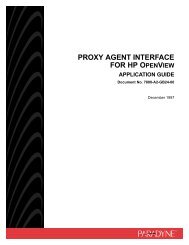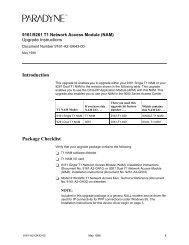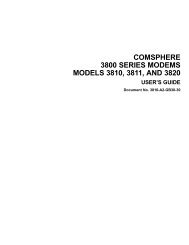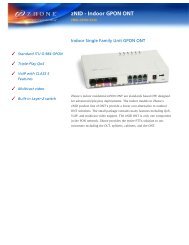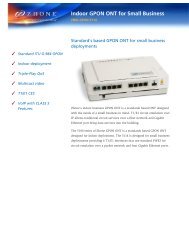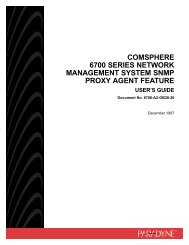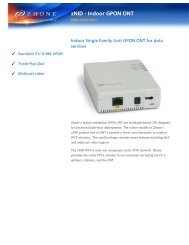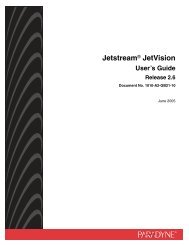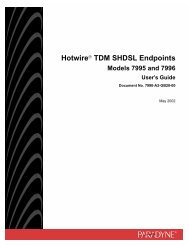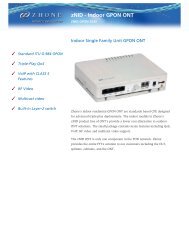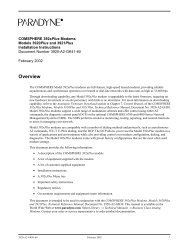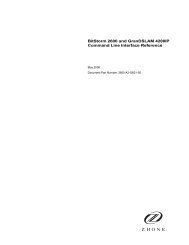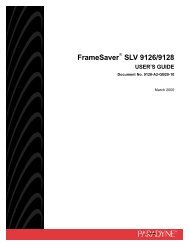Zhone Technologies Annual Report 2004
Zhone Technologies Annual Report 2004
Zhone Technologies Annual Report 2004
Create successful ePaper yourself
Turn your PDF publications into a flip-book with our unique Google optimized e-Paper software.
2002 and no longer amortizes goodwill. The Company evaluates goodwill, at a minimum, on an annual<br />
basis and whenever events and changes in circumstances suggest that the carrying amount may not be<br />
recoverable. Impairment of goodwill is tested at the reporting unit level by comparing the reporting unit’s<br />
carrying amount, including goodwill, to the fair value of the reporting unit. The Company has determined<br />
that it operates in a single segment with one operating unit. In 2002, the fair value of the reporting unit was<br />
estimated using a combination of the income, or discounted cash flows, approach and the market approach,<br />
which utilized comparable companies’ data. Effective November 2003, the Company performs the annual<br />
goodwill impairment test using the market approach, reflecting the fact that the Company’s stock was<br />
publicly traded following the consummation of the Tellium merger. If the carrying amount of the reporting<br />
unit exceeds its fair value, goodwill is considered impaired and a second step is performed to measure the<br />
amount of impairment loss, if any.<br />
(m) Purchased Intangibles and Other Long-Lived Assets<br />
In accordance with SFAS No. 144, long-lived assets, such as property, plant and equipment, and<br />
purchased intangibles subject to amortization, are reviewed for impairment whenever events or changes in<br />
circumstances indicate that the carrying amount of an asset may not be fully recoverable. Recoverability of<br />
assets to be held and used is measured by a comparison of the carrying amount of an asset to future net<br />
undiscounted cash flows expected to be generated by the asset. If the carrying amount of an asset exceeds its<br />
estimated future cash flows, an impairment charge is recognized by the amount by which the carrying<br />
amount of the asset exceeds the fair value of the asset. During the year ended December 31, 2002, the<br />
Company recorded an impairment loss on long-lived assets of $50.8 million. Any assets to be disposed of<br />
would be separately presented in the balance sheet and reported at the lower of the carrying amount or fair<br />
value less costs to sell, and would no longer be depreciated. The assets and liabilities of a disposed group<br />
classified as held for sale would be presented separately in the appropriate asset and liability sections of the<br />
balance sheet.<br />
Goodwill and other acquisition-related intangible assets not subject to amortization are tested annually<br />
for impairment, and are tested for impairment more frequently if events and circumstances indicate that the<br />
asset might be impaired. An impairment loss is recognized to the extent that the carrying amount exceeds<br />
the asset’s fair value. During the year ended December 31, <strong>2004</strong>, the Company recorded a charge of $0.2<br />
million related to impairment of the acquired workforce from Gluon.<br />
(n) Research and Product Development Expenditures<br />
Costs related to research, design, and development of products are charged to research and product<br />
development expense as incurred. Costs for the development of new software and substantial enhancements<br />
to existing software are expensed as incurred until technological feasibility has been established, at which<br />
time any additional development costs would be capitalized. The Company’s current process for developing<br />
software is essentially completed concurrently with the establishment of technological feasibility;<br />
accordingly, no costs have been capitalized to date.<br />
(o) Accounting for Stock-Based Compensation<br />
The Company has elected to account for employee stock options using the intrinsic-value method in<br />
accordance with Accounting Principles Board Opinion No. 25 (“APB 25”) and related interpretations.<br />
Under this method, compensation expense is recorded on the date of grant only if the current fair value<br />
exceeds the exercise price. SFAS No. 123, Accounting for Stock-Based Compensation, established<br />
accounting and disclosure requirements using a fair value-based method of accounting for stock-based<br />
employee compensation plans. As allowed by SFAS No. 123, the Company has elected to continue to apply<br />
the intrinsic value-based method of accounting described above, and has adopted the disclosure<br />
requirements of SFAS No. 123, as amended.<br />
38



